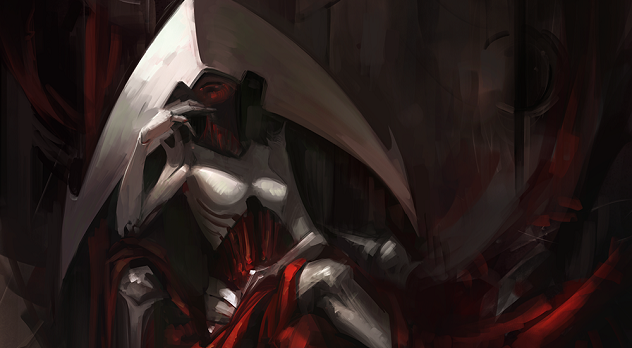
The title basically says it all. Instead (or in addition) to the D&D Alignments you use Magic Colors. In the more specific cases I will use the 5th Editions rules, but the basic idea should work in most systems where the alignments are not strongly intertwined with the rest of the system or if there is no alignment system in the first place.
The implications are as follows.
You end up with a less clear cut alignment system. Sure white is often good and black is often evil. But Elesh Norn (the woman in the title picture) is the most powerful Praetor of New Phyrexia, which is a very sinister place to life, and she is pure white.
People of different Colors can work together and share the same goals, but their view on life and what makes it important may be completely different. If you are unfamiliar with Magic here a short description of the five Colors (or at least how I perceive them).
- White is the color or law, peace and the sun. It favors the collective. The needs of the many are above the needs of the few. Clerics, paladins and soldiers are often white. Plains produce white mana.
- Blue is the color of intellect, rational thought and water. It favors careful planning. Better to provide against contingencies. Wizards, artificers and sea creatures are often blue. Islands produce blue mana.
- Black is the color of selfishness, death and decay. It favors the individual. When I do things for my sake, at least I know that I am happy. Warlocks, necromancers and the undead are often black. Swamps produce black mana.
- Red is the color of emotion, chaos and fire. It favors quick action. Let’s do this! Barbarians, sorcerers and goblins are often red. Mountains produce red mana.
- Green is the color of growth, instinct and nature. It favors the natural state. All things are connected. Druids, rangers and elves are often green. Forests produce green mana.
Every character can pick one or more colors he or she feels aligned to. It is also possible to choose no alignment and be colorless. Magic items and constructs are often colorless.
The Mana of the Land
In Magic characters draw their power from the land. A simple rule would be: Whenever the characters are at a location which favors a certain type of mana, everyone gains advantage on all rolls when he or she shares an alignment.
Example: An elf wizard (green blue), a human fighter (pure white) and a dwarf cleric (red white) travel through the wide plains. In this scenario the dwarf and the human would gain advantage on every roll since they are in their natural environment. If they would travel through the mountains only the dwarf would get the advantage. On a ship or in the forest the elf would have the advantage. In a swamp however neither of them would get advantages since none of them are Black. Cities tend to be colorless so they never provide advantage to anyone.
If a group arrives at a mana nexus for a certain color, characters aligned with that color may gain Inspiration.
Modified Spells
I would modify two spells to gain a bit more interaction with the Color System: Detect Magic and Magic Circle.
- Detect Magic: Since all living creature are a representation of magic, the spell would show an aura on every living thing. The aura has the color of the creature’s alignment. A colorless creature’s aura looks greyish.
- Magic Circle: Instead of naming any creature type, the caster may name exactly one color. The effects of this spell then apply to every creature aligned to the named color.
The picture was drawn by Side 34. Used without permission.
